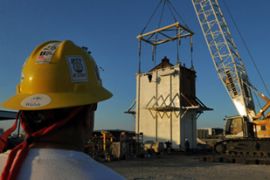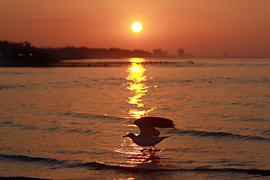BP seals off first Gulf oil leak
Smallest of the three leaks spilling oil into the Gulf of Mexico is “capped”, company says.

Dome prepped
Remote-controlled submarines are being used to guide the giant dome into place to try to stem the main leaks on Thursday, John Curry, a BP spokesman, said.
BP has never deployed such a structure at a depth of 1,500m and difficulties may occur, he said. It is expected to take more than two days.
| in depth | |
|
Satish Nagarajaiah, professor of civil engineering at Rice University in Houston, said it was hard to predict how successful this operation would be.
“I think they will be successful in collecting some amount of oil, bringing it up to a tanker,” he told Al Jazeera.
“But the chances of 100 per cent success, I’m not sure at this point of time because you’re operating in very difficult environments, 5,000 feet under water.”
It will take at least two days before the structure can be operational, meaning another 3.8 million litres of oil could be gushing into the sea.
Al Jazeera’s Rob Reynolds, reporting from the US state of Alabama, said the fact that BP capped one of three leaks at the well will “not cut the flow of oil but will at least make it easier to help with the gusher”.
“If the BP engineers can correctly place the dome over the source of the main leak then it will be several more days before ships can attach various hoses, valves and pipes to the containment dome which will then begin funnelling the oil up to the surface and that would effectively stop the vast majority of the leak,” Reynolds said.
Environmental impact
BP is in charge of the cleanupand Barack Obama, the US president, and many others have said the company also is responsible for the costs.
| Race to stop oil flow |
|
Engineers struggling to find a way to halt the flow of oil from the damaged well are working along three paths:
|
Meanwhile, the effort to protect Louisiana coastal wetlands was expected to pick up.
According to BP projections, the slick was not expected to reach land for another three days.
According to visual reports from the air, the reddish orange sheen of the slick was broken up into either side of the Chandeleur islands – a chain of uninhabited islets some 90km east of New Orleans that is a prime marsh and wildlife area – and appeared to be lapping the shore.
Coast guard Rear Admiral Mary Landry said while it was expected some surface oil sheen would eventually reach the shore, the containment operation was tracking “heavy pockets of emulsified oil” to prevent them from hitting the coastline.
An estimated 760,000 litres of crude a day has been leaking out of three openings at the wellhead below the Deepwater Horizon rig since it sank on April 22.
There are concerns that powerful sea currents could eventually take the spill to Miami Beach or North Carolina’s barrier islands further south.
Pledging compensation
BP has taken responsibility for the Deepwater Horizon spill, saying it will pay for all clean-up costs and compensation for legitimate claims for property damage, personal injury and commercial losses.
The Pentagon has approved the deployment of more than 17,000 troops from four states to help contain the spill.
 |
| Authorities in Louisiana are in a race against time to stop oil washing up on shore [AFP] |
Meanwhile environmentalists are worried that oil-dispersing chemicals used in the clean-up could pose a danger to marine life, even as it helps keep the slick from reaching the vulnerable coast.
The US Environmental Protection Agency has approved 14 dispersants for use on oil spills, seen as a trade-off between potential short-term harm to offshore wildlife and possible long-term damage to coastal wildlife habitat.
Sea turtles, dolphins and whales have been seen swimming through the oil slick, and bluefin tuna spawning grounds were not far from its southwest edge as of last Friday, according to the National Oceanic and Atmospheric Administration (NOAA).
Closer to shore are oyster beds and seagrass beds – where dolphins, birds, lobster, conch, scallops, shrimp and juvenile fish seek food and shelter – as well as barrier island bird nests, loggerhead turtle nests, sea turtle nests and essential fish habitat, said marine environmental group Oceana, citing NOAA and the Unified Command working on the spill.
Jackie Savitz, a senior scientist at Oceana, told the Reuters news agency that the problem is the dispersants themselves can be toxic to wildlife, and can enhance oil’s toxicity in the dispersion process.
“A decision is being made where it’s the shore wildlife and oysters and beaches versus the animals that live in the water.”

 Breaking up oil as it emerges from damaged pipes by injecting chemicals into waters near wellhead – early tests show some success, but does nothing to stop flow
Breaking up oil as it emerges from damaged pipes by injecting chemicals into waters near wellhead – early tests show some success, but does nothing to stop flow